Posted under Spain
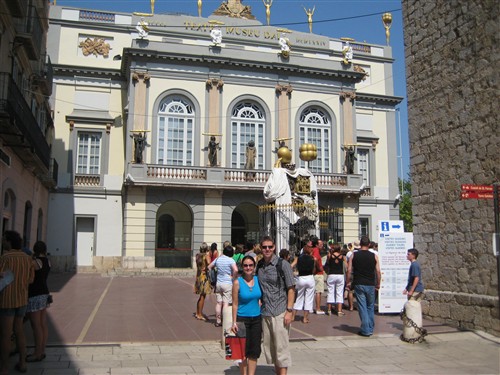
Salvador Dali (1904-89), born in the small Spanish town of Figueres just a few kilometers south of the French border, is regarded by many to be one of the greatest artists of the twentieth century. He is also one of our personal favorites. In the 1960’s and 70’s, Dali created the Teatre-Museu Dali in Figueres, a culmination of his life’s work and the single greatest surrealist piece of art in the world. We decided to use our last day in Spain to make the pilgrimage, a two-hour train ride north from Barcelona.
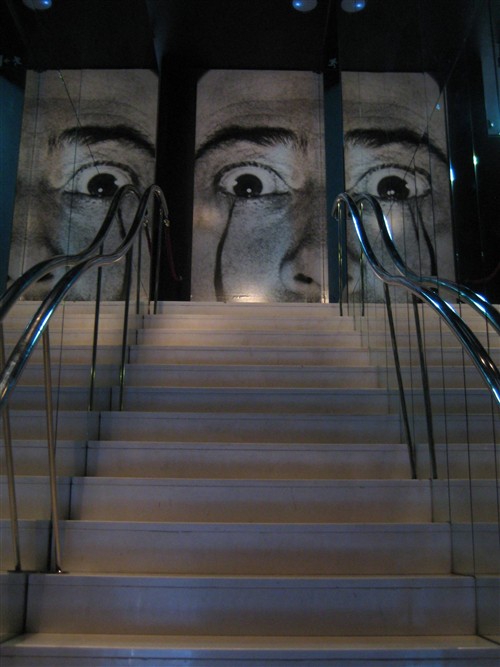 The Figueres’ former municipal theater, burned and destroyed during the Spanish civil war, was personally converted by Dali to create the museum. A brochure that we picked up at the museum entrance suggested that “the Dali Theatre-Museum should be seen as a whole, for Dali conceived and designed everything in it with the aim of offering the visitor a veritable aesthetic experience, and the opportunity of entering the artist’s unique, fascinating world.” And what an amazing world it was, filled with Dali’s psychedelic and spectral images! Tina is unshakably convinced that there must have been some fantastic hallucinogens in Gaudi and Dali’s time. After two hours of wandering around the multilevel amphitheatre we were both overwhelmed by the artist’s unique and varied creations – paintings, drawings, sculptures, gold, jewels, and installations. Dali was certainly not confined to the medium of painting for which he is most famous. He liked to paint his wife, Gala. He liked to create things that move. Filled with cartoon-like sketches, enormous wall-covering paintings, surrealistic oil paintings, doorways morphed into giant faces, and a chaotic array of sculptures and installations, the museum left us speechless. It was easily one of our favorite museums in the world.
The Figueres’ former municipal theater, burned and destroyed during the Spanish civil war, was personally converted by Dali to create the museum. A brochure that we picked up at the museum entrance suggested that “the Dali Theatre-Museum should be seen as a whole, for Dali conceived and designed everything in it with the aim of offering the visitor a veritable aesthetic experience, and the opportunity of entering the artist’s unique, fascinating world.” And what an amazing world it was, filled with Dali’s psychedelic and spectral images! Tina is unshakably convinced that there must have been some fantastic hallucinogens in Gaudi and Dali’s time. After two hours of wandering around the multilevel amphitheatre we were both overwhelmed by the artist’s unique and varied creations – paintings, drawings, sculptures, gold, jewels, and installations. Dali was certainly not confined to the medium of painting for which he is most famous. He liked to paint his wife, Gala. He liked to create things that move. Filled with cartoon-like sketches, enormous wall-covering paintings, surrealistic oil paintings, doorways morphed into giant faces, and a chaotic array of sculptures and installations, the museum left us speechless. It was easily one of our favorite museums in the world.
 Our tickets granted us entry to another of Dali’s museums nearby, the Dali Joies (Dali Jewels). In the 1940’s, Dali was commissioned to design a collection of jewelry. The result was an eclectic display of beautiful bejeweled anthropomorphic creations including The Eye of Time, an eye-shaped mosaic of platinum, ruby and diamonds and The Royal Heart, a solid gold heart with an inset ruby-encrusted, mechanized heart that appeared to beat. Dali summarizes his collection best. “The jeweled pieces – ornaments, medals, crosses, objets d’art – you find are not conceived to rest soullessly in steel vaults. They were created to please the eye, uplift the spirit, stir the imagination, express convictions. Without an audience, without the presence of spectators, these jewels would not fulfill the function for which they came into being. The viewer, then, is the ultimate artist. His sight, heart, mind – fusing with and grasping with greater or lesser understanding the intent of the creator – gives them life.”
Our tickets granted us entry to another of Dali’s museums nearby, the Dali Joies (Dali Jewels). In the 1940’s, Dali was commissioned to design a collection of jewelry. The result was an eclectic display of beautiful bejeweled anthropomorphic creations including The Eye of Time, an eye-shaped mosaic of platinum, ruby and diamonds and The Royal Heart, a solid gold heart with an inset ruby-encrusted, mechanized heart that appeared to beat. Dali summarizes his collection best. “The jeweled pieces – ornaments, medals, crosses, objets d’art – you find are not conceived to rest soullessly in steel vaults. They were created to please the eye, uplift the spirit, stir the imagination, express convictions. Without an audience, without the presence of spectators, these jewels would not fulfill the function for which they came into being. The viewer, then, is the ultimate artist. His sight, heart, mind – fusing with and grasping with greater or lesser understanding the intent of the creator – gives them life.”
A short train ride south from Figueres is the picturesque town of Girona, idyllically perched on a riverbank with colorfully-painted houses and a rustic medieval town center. We stopped there on our way back to Barcelona and sat for a late lunch at one of the outdoor cafés. We wandered through the narrow winding streets, visiting the town’s cathedral, stopping for photos and gelato. Girona is not a major tourist destination, overflowing with historical sights, but rather a charming little town straddling a lazy river. We found its tranquil streets a refreshing change from the frenetic pace of Barcelona and the shoulder-to-shoulder crowds at the Dali museum.
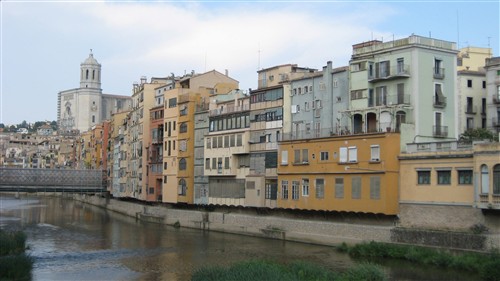
And so our days in Spain have come to an end. We have truly enjoyed the sangria, the paella and gelato; the vibrant colors, the music and the laid back attitudes of the Spanish people. Life in Spain seems refreshingly immune to the frenetic pace of much of the Western world. Barcelona, jewel of the Mediterranean, is a conglomeration of Spain’s best attributes – stunning architecture, a relaxed café culture, world class museums, historic medieval neighborhoods, and one of the most enjoyable beaches we’ve ever experienced. Lladro. Picasso. Dali. Gaudi. Spain makes the world beautiful.
 Never again will we underestimate the contributions of the Spanish to the overall beauty of the world…and I’m not just talking about the dark hair, Mediterranean skin and heaving cleavage. We have waded into the Barcelona art scene, a playground of Picasso and Modernista architect, Antoni Gaudi. With six nights to play, we felt sure that we could visit Barcelona’s most impressive sights with plenty of time leftover for sangria and the beach. We were mostly right.
Never again will we underestimate the contributions of the Spanish to the overall beauty of the world…and I’m not just talking about the dark hair, Mediterranean skin and heaving cleavage. We have waded into the Barcelona art scene, a playground of Picasso and Modernista architect, Antoni Gaudi. With six nights to play, we felt sure that we could visit Barcelona’s most impressive sights with plenty of time leftover for sangria and the beach. We were mostly right.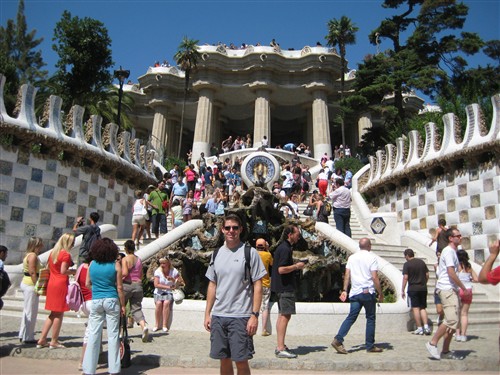 We devoted an entire day to admiring Gaudi’s brilliant work, beginning with a visit to Park Guell. The project began in 1900, on a piece of prime real estate overlooking the sea, as a housing development for the wealthy but ended fourteen years later as a commercial failure. The city later purchased the incomplete development and turned it into a public park. From the metro stop, a series of escalators carried excitable tourists up the side of a steep hill. Once inside the park, landscaped gravel walking trails wound around the hillside overlooking the Mediterranean. The trails eventually led to the remnants of Gaudi’s creations for the original housing development project: two “gingerbread” gatehouses, a colorful, curvy plaza and 3km of roads, walks and steps. The park was a beautiful place for a picnic and many people had copped a squat in the pillared pavilion at the entry while musicians played for tips. The plaza was a large open area surrounded by a squiggly mosaic bench and it was there that I really began to visualize the potential of the original project. It would have been like living in a fun house with pretty touches everywhere to make people smile. That was Gaudi’s way.
We devoted an entire day to admiring Gaudi’s brilliant work, beginning with a visit to Park Guell. The project began in 1900, on a piece of prime real estate overlooking the sea, as a housing development for the wealthy but ended fourteen years later as a commercial failure. The city later purchased the incomplete development and turned it into a public park. From the metro stop, a series of escalators carried excitable tourists up the side of a steep hill. Once inside the park, landscaped gravel walking trails wound around the hillside overlooking the Mediterranean. The trails eventually led to the remnants of Gaudi’s creations for the original housing development project: two “gingerbread” gatehouses, a colorful, curvy plaza and 3km of roads, walks and steps. The park was a beautiful place for a picnic and many people had copped a squat in the pillared pavilion at the entry while musicians played for tips. The plaza was a large open area surrounded by a squiggly mosaic bench and it was there that I really began to visualize the potential of the original project. It would have been like living in a fun house with pretty touches everywhere to make people smile. That was Gaudi’s way.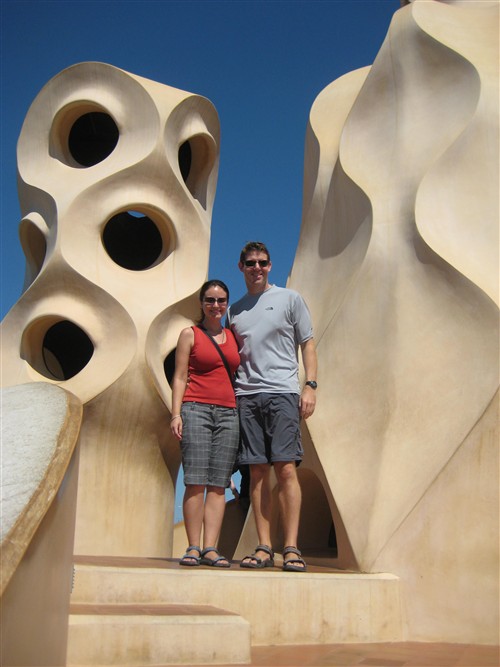 After the park, we moved on to another one of Gaudi’s creations – La Pedrera – an apartment building commissioned by a well-to-do couple. “La Pedrera”, meaning stone quarry, was a nickname given to the building because it looks like it is carved out of stone. The completed building consists of two blocks of apartments, each with its own interior courtyard, and with one continuous façade that curves around a corner lot. An apartment on the fourth floor was decorated as it would have been in the early 1900’s, when it was inhabited by the Barcelona bourgeois. The floor plan encircled a large interior courtyard, filling the apartment with light. From the swirling ceilings and parquet floors to the moulding, door knobs and other ornamental embellishments, every detail of the interior has Gaudi’s personal touch.
After the park, we moved on to another one of Gaudi’s creations – La Pedrera – an apartment building commissioned by a well-to-do couple. “La Pedrera”, meaning stone quarry, was a nickname given to the building because it looks like it is carved out of stone. The completed building consists of two blocks of apartments, each with its own interior courtyard, and with one continuous façade that curves around a corner lot. An apartment on the fourth floor was decorated as it would have been in the early 1900’s, when it was inhabited by the Barcelona bourgeois. The floor plan encircled a large interior courtyard, filling the apartment with light. From the swirling ceilings and parquet floors to the moulding, door knobs and other ornamental embellishments, every detail of the interior has Gaudi’s personal touch. Exhausted but still trudging along, we made our way to Gaudi’s most famous creation and Barcelona’s most famous work-in-progress: La Sagrada Familia. Begun in 1882, the church was the project to which Gaudi dedicated the latter part of his life and was left incomplete when Gaudi died in 1926. It is an awe-inspiring synergy of a traditional Gothic design and Gaudi’s shocking Modernista flair. Stunning sculptured façades seem to jump off the church and the narrow pointed towers are breathtaking to behold. La Sagrada Familia looks more like a fairy tale castle than a church. Work continues slowly, according to Gaudi’s original designs. The completed structure will be a glorious monument to an artist who left an unforgettable mark on Barcelona. The photos simply do not do it justice. It is a church unlike any the world has ever seen.
Exhausted but still trudging along, we made our way to Gaudi’s most famous creation and Barcelona’s most famous work-in-progress: La Sagrada Familia. Begun in 1882, the church was the project to which Gaudi dedicated the latter part of his life and was left incomplete when Gaudi died in 1926. It is an awe-inspiring synergy of a traditional Gothic design and Gaudi’s shocking Modernista flair. Stunning sculptured façades seem to jump off the church and the narrow pointed towers are breathtaking to behold. La Sagrada Familia looks more like a fairy tale castle than a church. Work continues slowly, according to Gaudi’s original designs. The completed structure will be a glorious monument to an artist who left an unforgettable mark on Barcelona. The photos simply do not do it justice. It is a church unlike any the world has ever seen.
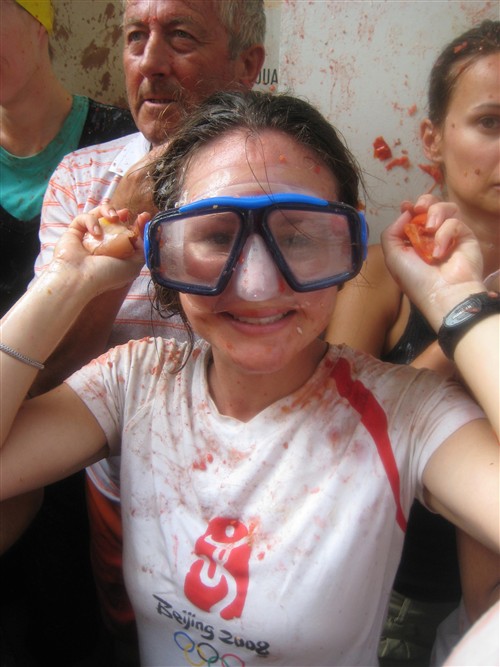 We checked into our three-star hotel in Valencia – the cheapest room we could find during La Tomatina – joking that it was three more stars than we usually get. The tomato fight takes place in Buñol, a town of about 8,000 people, 40 kms away, but Buñol has little in the way of accommodation so everyone stays in Valencia and trains in for the event, with the exception of those who drink all night in Buñol the night before and sleep on the street. That’s not really our style.
We checked into our three-star hotel in Valencia – the cheapest room we could find during La Tomatina – joking that it was three more stars than we usually get. The tomato fight takes place in Buñol, a town of about 8,000 people, 40 kms away, but Buñol has little in the way of accommodation so everyone stays in Valencia and trains in for the event, with the exception of those who drink all night in Buñol the night before and sleep on the street. That’s not really our style.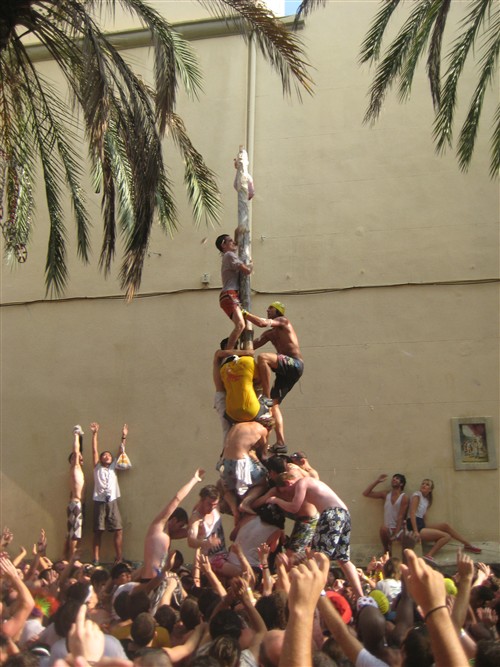 The ham pole went up around nine. An integral part of the annual tomato fight, a telephone pole with a ham leg tied to the top is fastened into the ground. The pole is slathered from top to bottom with a thick layer of what looked like animal lard but smelled more like soap. Per tradition, the crowd must climb the pole and cut down the ham before the tomato fight can begin. With two hours and a little coordination, that should be no problem, I thought to myself. Wrong!
The ham pole went up around nine. An integral part of the annual tomato fight, a telephone pole with a ham leg tied to the top is fastened into the ground. The pole is slathered from top to bottom with a thick layer of what looked like animal lard but smelled more like soap. Per tradition, the crowd must climb the pole and cut down the ham before the tomato fight can begin. With two hours and a little coordination, that should be no problem, I thought to myself. Wrong! Thankfully, Aaron and I had established a rendezvous point and found each other again shortly before the bell rang to announce the end of the tomato fight. We were exhilarated, exhausted, and covered in tomato from head to toe. It was caked in my hair, stuck to our clothes, and coming out of our ears. Luckily, our scuba masks had worked perfectly, leaving our eyes the only body part immune from the mess. As the crowd shuffled slowly back uphill toward the train station, the sun which had remained sympathetically hidden behind the clouds all morning, made its glorious entrance and I began to feel the acidity of the tomatoes on my skin. Many good-spirited locals sprayed hoses into the crowd but there were so many people vying for the same sprinkles. We arrived at the train station to find long lines everywhere…long lines for the now disgustingly vile portable toilets, long lines for the makeshift showers, and long lines for the trains. We paid our dues in all three lines over a span of two hours before finally boarding the train back to Valencia.
Thankfully, Aaron and I had established a rendezvous point and found each other again shortly before the bell rang to announce the end of the tomato fight. We were exhilarated, exhausted, and covered in tomato from head to toe. It was caked in my hair, stuck to our clothes, and coming out of our ears. Luckily, our scuba masks had worked perfectly, leaving our eyes the only body part immune from the mess. As the crowd shuffled slowly back uphill toward the train station, the sun which had remained sympathetically hidden behind the clouds all morning, made its glorious entrance and I began to feel the acidity of the tomatoes on my skin. Many good-spirited locals sprayed hoses into the crowd but there were so many people vying for the same sprinkles. We arrived at the train station to find long lines everywhere…long lines for the now disgustingly vile portable toilets, long lines for the makeshift showers, and long lines for the trains. We paid our dues in all three lines over a span of two hours before finally boarding the train back to Valencia.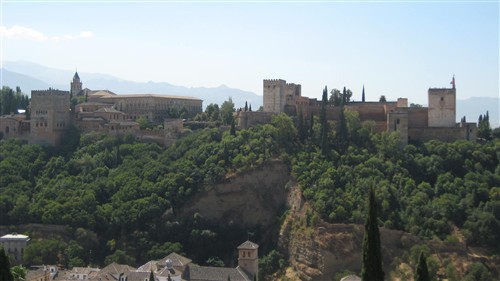
 The palace was exquisite. The rooms were elaborately decorated with mosaic tilework, carved wooden ceilings, molded stucco walls with intricate lace patterns, and traditional Arabic calligraphy. There were picturesque courtyards with manicured gardens, reflecting pools and a labyrinth of covered corridors connecting it all. The design and décor of the Palacio Nazaries was similar to the other medersas and Arab-Islamic palaces that we’ve seen in Morocco and southern Spain but we were awed by it nonetheless. The sheer magnitude of the Alhambra was impressive. The Generalife, or architect’s garden, was a pristinely manicured labyrinth of hedged corridors, arbors, cypress trees, and flowers of every imaginable color. Its magic compelled even the most macho of men to pose giddily for photos among its storybook backdrops.
The palace was exquisite. The rooms were elaborately decorated with mosaic tilework, carved wooden ceilings, molded stucco walls with intricate lace patterns, and traditional Arabic calligraphy. There were picturesque courtyards with manicured gardens, reflecting pools and a labyrinth of covered corridors connecting it all. The design and décor of the Palacio Nazaries was similar to the other medersas and Arab-Islamic palaces that we’ve seen in Morocco and southern Spain but we were awed by it nonetheless. The sheer magnitude of the Alhambra was impressive. The Generalife, or architect’s garden, was a pristinely manicured labyrinth of hedged corridors, arbors, cypress trees, and flowers of every imaginable color. Its magic compelled even the most macho of men to pose giddily for photos among its storybook backdrops. The Albayzin, the old Muslim quarter sprawling up a hill facing the Alhambra, afforded the best views of the fortress-palace. The Albayzin was a maze of narrow alleys meandering within the old stone ramparts. The neighborhood, though largely residential, had lovely plazas with outdoor cafes, small shops selling souvenirs and Moroccan imports, and remnants of mosques-turned-churches. The five kilometer walking tour, winding through zigzagging streets, up and down the hillside, was a great opportunity to stretch our legs and work off some of that gelato.
The Albayzin, the old Muslim quarter sprawling up a hill facing the Alhambra, afforded the best views of the fortress-palace. The Albayzin was a maze of narrow alleys meandering within the old stone ramparts. The neighborhood, though largely residential, had lovely plazas with outdoor cafes, small shops selling souvenirs and Moroccan imports, and remnants of mosques-turned-churches. The five kilometer walking tour, winding through zigzagging streets, up and down the hillside, was a great opportunity to stretch our legs and work off some of that gelato.
 After a casual lunch at one of the ubiquitous outdoor cafés, we made our way to Cordoba’s most impressive sight – the Mezquita, meaning mosque in Spanish. The Mezquita is also commonly referred to as the Cathedral of Cordoba, which seems contradictory until the story of its current incarnation unfolds.
After a casual lunch at one of the ubiquitous outdoor cafés, we made our way to Cordoba’s most impressive sight – the Mezquita, meaning mosque in Spanish. The Mezquita is also commonly referred to as the Cathedral of Cordoba, which seems contradictory until the story of its current incarnation unfolds.
